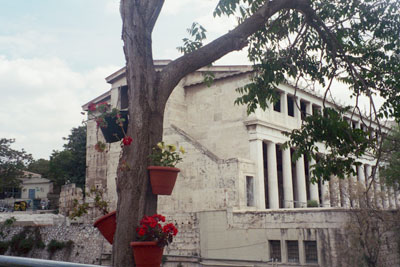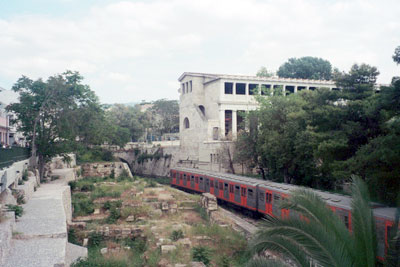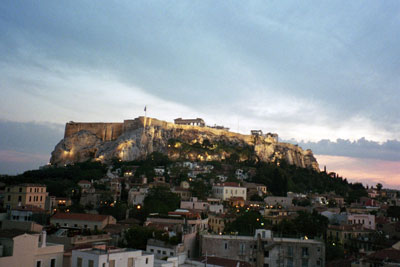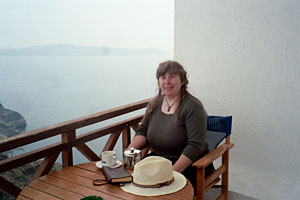"My" Athens
Afternoon, Sunday May 1st

So how was the journey here? Long and far. It began at 3:45 AM two days ago with a shuttle ride to Los Angeles, an hour away from home, and then a flight six hours from Los Angeles to New York, which used up so much time fussing on the runway that I nearly got to reenact Ariadne's least favorite moment. I caught the flight to Athens just in time. Overseas flights are so long. Somehow the night seems darker with the deep ocean beneath rather than solid ground. In the morning, we flew down the coast of Italy. Below I could clearly make out the long rectangular strips of the iugera, Roman fields kept cultivated to this day, and the port of Brundisium settled by Greeks was nestled where it should be upon the heel. There was lingering snow on the Appenines, and more in the rugged heights of Greece when we crossed over the short strait of sea to the other side. Somehow I had not grasped how sharp, how rugged were its mountains.
Customs was easy— waiting for the bags, not so easy! In the airport I caught up with some of the other ladies who were on this journey. One of them had booked a ride online with George's Famous Taxi, and lo and behold he was more prompt to meet us than my LA shuttle had been! We decanted at the Central Hotel on Apollonos (Apollo) Street, after a bewildering ride through many narrow alleys. After unwinding in my room, I came down to find Chris welcoming arrivals on a balcony above the lobby. She recommended that I set out and begin my explorations at once. So, armed with a detailed map in hand, I ambled out into tiny streets, most paved with flagstones and flanked by shops and friendly people. There was an amazing (well, not really) amount of replica Greek art: statues and red-figure vases, even Cycladic figurines, most of which I was more used to seeing from the opposite end of a slide projector.

At length I found my way to the... Stoa of Attalos! Not a name the casual tourist would know, but for me it was strangely surreal, like finding an old school friend having lunch at the bottom of the grand canyon. It was built about a hundred and fifty years after the time of Alexander the Great by King Attalos II of Pergamon, one of many dynasties founded by the generals of Alexander carving up his empire. By that time, Athens was already considered a classic, dwelling on her former glories. Petty tyrants, kings, and emperors would pay homage to her by paying for fine monuments there. Hence the stoa, whose long arcade would have housed shops or perhaps an art museum, which is how it functions today. How strange to find it side by side with a modern metro service, the ruined blocks of a Roman forum just on the other side.

The stoa faced onto the Agora, the civic heart of ancient Athens, now a green tumbled wilderness of bushes, flowers, long grass, and ruined marble. Alas, this was the day before Orthodox Easter, so I found it closed. So I wandered on, disappointing various merchants by looking, not buying. I stopped in a random shop at 3PM, hungry and tired and confused about time, and had my first Greek salad and lamb, a staple in these parts. Obviously I was an out-of-towner; the rest of the city was fasting for the next day.
I found Raquel my roommate for this expedition in the room when I returned. At sunset we climbed up to the hotel's rooftop for orientation, and there we gazed at the rock of the Acropolis looming up behind us with the Parthenon solid and real in the distance. Chris began her lectures by speaking of “her” Greece, her lived experience of this place, and how it’s new each time. She spoke of hopes and fears of coming to a land steeped in legend, of how we might fear that real Greece might not match the imaginal one. Turning to Greece itself, she spoke of two strata in its culture and history— early Greece, steeped in ritual and cult and reverence for goddesses, and the Greece of classical times, a patriarchal world where mythology and gods were the stuff of literature as much as cult.

The sunset behind the Acropolis was a stunning backdrop for dinner, although the evening air was biting cold. Some of the group went out into the city to attend late Easter services and drink in the pagentry, the singing, and the local custom of breaking eggs dyed a deep dark red; a tradition to honor rebirth and spring that most certainly predates the name they called out while doing it. I had wondered why our hotel had left us two eggs in a basket! I was cold and tired and wary of walking city streets at night, but there on the rooftop we had a view of the whole city laid out before us. Athens is no more level than Rome, so up and down the hills we could see many people processing or holding candles. The soaring choruses of hundreds of voices singing from cathedral and church and square made the city resonate. Chilled and wondering, we stood entranced.
Around midnight, bright fireworks and gunshots went up all over the city, and the many layers of bells ringing and interweaving from all directions brought tears to our eyes. The sound echoed off the cliffs of the Acropolis. There alone, an island of silence in a sea of music and thunder, the shrines and monuments of a different world stood stoically abandoned, their marble columns bathed in golden light from many spotlights that illumined them all night long.

So how was the journey here? Long and far. It began at 3:45 AM two days ago with a shuttle ride to Los Angeles, an hour away from home, and then a flight six hours from Los Angeles to New York, which used up so much time fussing on the runway that I nearly got to reenact Ariadne's least favorite moment. I caught the flight to Athens just in time. Overseas flights are so long. Somehow the night seems darker with the deep ocean beneath rather than solid ground. In the morning, we flew down the coast of Italy. Below I could clearly make out the long rectangular strips of the iugera, Roman fields kept cultivated to this day, and the port of Brundisium settled by Greeks was nestled where it should be upon the heel. There was lingering snow on the Appenines, and more in the rugged heights of Greece when we crossed over the short strait of sea to the other side. Somehow I had not grasped how sharp, how rugged were its mountains.
Customs was easy— waiting for the bags, not so easy! In the airport I caught up with some of the other ladies who were on this journey. One of them had booked a ride online with George's Famous Taxi, and lo and behold he was more prompt to meet us than my LA shuttle had been! We decanted at the Central Hotel on Apollonos (Apollo) Street, after a bewildering ride through many narrow alleys. After unwinding in my room, I came down to find Chris welcoming arrivals on a balcony above the lobby. She recommended that I set out and begin my explorations at once. So, armed with a detailed map in hand, I ambled out into tiny streets, most paved with flagstones and flanked by shops and friendly people. There was an amazing (well, not really) amount of replica Greek art: statues and red-figure vases, even Cycladic figurines, most of which I was more used to seeing from the opposite end of a slide projector.

At length I found my way to the... Stoa of Attalos! Not a name the casual tourist would know, but for me it was strangely surreal, like finding an old school friend having lunch at the bottom of the grand canyon. It was built about a hundred and fifty years after the time of Alexander the Great by King Attalos II of Pergamon, one of many dynasties founded by the generals of Alexander carving up his empire. By that time, Athens was already considered a classic, dwelling on her former glories. Petty tyrants, kings, and emperors would pay homage to her by paying for fine monuments there. Hence the stoa, whose long arcade would have housed shops or perhaps an art museum, which is how it functions today. How strange to find it side by side with a modern metro service, the ruined blocks of a Roman forum just on the other side.

The stoa faced onto the Agora, the civic heart of ancient Athens, now a green tumbled wilderness of bushes, flowers, long grass, and ruined marble. Alas, this was the day before Orthodox Easter, so I found it closed. So I wandered on, disappointing various merchants by looking, not buying. I stopped in a random shop at 3PM, hungry and tired and confused about time, and had my first Greek salad and lamb, a staple in these parts. Obviously I was an out-of-towner; the rest of the city was fasting for the next day.
I found Raquel my roommate for this expedition in the room when I returned. At sunset we climbed up to the hotel's rooftop for orientation, and there we gazed at the rock of the Acropolis looming up behind us with the Parthenon solid and real in the distance. Chris began her lectures by speaking of “her” Greece, her lived experience of this place, and how it’s new each time. She spoke of hopes and fears of coming to a land steeped in legend, of how we might fear that real Greece might not match the imaginal one. Turning to Greece itself, she spoke of two strata in its culture and history— early Greece, steeped in ritual and cult and reverence for goddesses, and the Greece of classical times, a patriarchal world where mythology and gods were the stuff of literature as much as cult.

The sunset behind the Acropolis was a stunning backdrop for dinner, although the evening air was biting cold. Some of the group went out into the city to attend late Easter services and drink in the pagentry, the singing, and the local custom of breaking eggs dyed a deep dark red; a tradition to honor rebirth and spring that most certainly predates the name they called out while doing it. I had wondered why our hotel had left us two eggs in a basket! I was cold and tired and wary of walking city streets at night, but there on the rooftop we had a view of the whole city laid out before us. Athens is no more level than Rome, so up and down the hills we could see many people processing or holding candles. The soaring choruses of hundreds of voices singing from cathedral and church and square made the city resonate. Chilled and wondering, we stood entranced.
Around midnight, bright fireworks and gunshots went up all over the city, and the many layers of bells ringing and interweaving from all directions brought tears to our eyes. The sound echoed off the cliffs of the Acropolis. There alone, an island of silence in a sea of music and thunder, the shrines and monuments of a different world stood stoically abandoned, their marble columns bathed in golden light from many spotlights that illumined them all night long.


0 Comments:
Post a Comment
<< Home